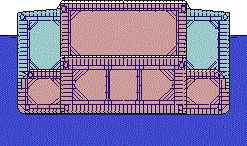The Coulombi Egg Oil Tanker - The M/T Limburg Accident Better protection, safer and more economical than Double Hull

|
 |
|
Start
page |
|
This was the first time that a serious explosion
occurred in a double hull VLCC and the question is
of course what caused it?
|
|
Water then flowed into the empty side ballast tank and the fracture in the inner shell allowed all the oil in the damaged cargo wing tank, which happened to be loaded, to flow out where it caught fire. First the oil above the waterline flowed out by gravity, later the last bottom oil in the cargo wing tank was forced out by water flowing into the cargo tank. The double side hull ballast tank was empty and it should first have been flooded and the tanker should have heeled a little towards the damage.
Had the same initial event happened to a partly loaded COULOMBI EGG tanker all cargo had been loaded in the upper centre tanks and nothing had happened - no fire, no oil spill. The same thing would have happened if the COULOMBI EGG tanker was fully loaded. This was not one of the design conditions of the COULOMBI EGG tanker but is a logical consequence of the COULOMBI EGG tanker design. However, the COULOMBI EGG tanker fire extinguishing system provides for the top side ballast tank being filled with foam due to the risk of a fire there. Had the 'M/T Limburg' by chance carried the part oil cargo in the centre tanks there would have been no fire or oil spill. No hull structural damage report or insurance incident report clarifying what really happened to the 'M/T Limburg' and if the crew tried to save the ship has ever been issued to be available on the Internet so nobody knows what really happened. Contact anders.bjorkman@wanadoo.fr |